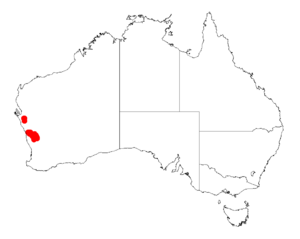Acacia isoneura facts for kids
Quick facts for kids Acacia isoneura |
|
|---|---|
| Scientific classification | |
| Genus: |
Acacia
|
| Species: |
isoneura
|
 |
|
| Where this plant grows (from AVH data) | |
Acacia isoneura is a type of shrub that belongs to the Acacia plant family. It is a special plant because it is endemic to western Australia, meaning it only grows naturally in that part of the world.
About the Plant
This shrub usually grows to be about 0.5 to 4 meters (1.6 to 13 feet) tall. It has a rounded, cone-like shape. Its branches are smooth (this is called glabrous, meaning hairless) and have a silky feel between the ridges, especially near the tips.
The leaves of this plant are called phyllodes. They are green to grey-green and also smooth. They are soft and can bend easily. These leaves are pointy and measure about 7 to 14 centimeters (2.7 to 5.5 inches) long. They are quite thin, only about 0.5 to 1.2 millimeters wide. Each leaf has eight wide veins with narrow grooves in between them.
Acacia isoneura blooms from July to September, showing off bright yellow flowers. The flower clusters (called inflorescences) grow alone or in pairs where the leaves meet the stem (this spot is called the axil). They are shaped like a short cylinder, about 8 to 15 millimeters long, and are full of golden flowers.
After the flowers, the plant forms seed pods. These pods are thin and papery (this is called chartaceous). They can be straight or look like a string of beads. They are about 3 to 6 centimeters (1.2 to 2.4 inches) long and 2 to 2.5 millimeters wide. Inside the pods, the seeds are shiny and mottled grey-brown to light brown. They are arranged lengthwise and are about 2 to 3 millimeters long.
Plant Family
Scientists have identified two different types, or subspecies, of Acacia isoneura:
- Acacia isoneura subsp. isoneura
- Acacia isoneura subsp. nimia
Where it Grows
This plant is found naturally in the Mid West and Wheatbelt areas of Western Australia. It likes to grow in flat areas, sandy plains, small hills, and ridges. You can often find it in stony, sandy soils. Most of these plants are located from Mingenew in the north down to Perenjori and Wubin in the south.

